p.93
p.98
p.103
p.108
p.115
p.120
p.125
p.131
p.141
Improved Synthesis Method of SiO2@Ag Core-Shell for Detection of Toxic Metals in Water
Abstract:
Silvernanoshell consisting of Ag coated on SiO2 core was synthesized and employed as a colorimetric probe for detection of toxic metals ions in water. The SiO2@Ag Core-Shell preparation method was fine-tuned and adjusted to prepare a mono-dispersed and fully encapsulated Ag nanoshell. Silica core spheres with the average diameter of 100 nm was prepared by Stöber method and subsequently coated with AgNPs by Seed-Mediated Growth Technique using NaBH4 as a reducing agent and PVA as a stabilizer. The resulting Ag nanoparticles tethered on silica spheres were found to serve as nucleation sites for the further growth of a silver nanoshell overlayers. The SiO2@Ag was characterized by UV-Visible Spectroscopy and Transmission Electron Microscopy. It was found that the AgNPs was successfully coated on the surface of silica spheres with the average thickness around 20 nm. The adsorptivity of metal ions onto the surface of Ag nanoshell were tested and calibrated using series of Hg2+ and Pb2+ ions with various concentrations. The changes in the band intensity of the surface plasmonresonance (SPR) band, which correspond to the changes in the concentration of ions in model waste water, were evident.
Info:
Periodical:
Pages:
115-119
Citation:
Online since:
October 2017
Authors:
Keywords:
Price:
Сopyright:
© 2017 Trans Tech Publications Ltd. All Rights Reserved
Share:
Citation:


